Functional Model of an Automatic Vehicle Hold Based on an Electro-Hydraulic Braking System
Abstract
1. Introduction
2. Automatic Vehicle Hold Function Design Based on the Electro-Hydraulic Braking System
2.1. Electro-Hydraulic Brake System Function
2.2. Automatic Vehicle Hold Function Introduction
2.3. Automatic Vehicle Hold Software Functions
2.4. Target Fluid Pressure Calculation Module
2.5. Parking Function Unit Module
3. Park and Start Analysis
3.1. Dynamic Analysis of the Automatic Vehicle Hold Function
3.2. The Variation of Forces during the Starting Process
3.3. Automatic Vehicle Hold Control Strategy for the Electro-Hydraulic Brake System
4. Real Vehicle Tests
4.1. Automotive Vehicle Hold Function Verified without Slope Condition
4.2. Validation of the Automatic Vehicle Hold Function under Ramp Conditions
5. Conclusions
- (1)
- Based on the platform of the electro-hydraulic braking system, the automatic vehicle hold function software is designed to improve the driver’s leg convenience and reduce the risk of skidding on ramps when the vehicle is parked and started. In this paper, a complete automatic vehicle hold system is designed by building a Simulink/Matlab model to ensure the vehicle is stably parked and started on flat ground and ramps.
- (2)
- The software function designed in this paper can preset the target hydraulic pressure directly through calibration. At the same time, multi-level ramp angle switching to different target hydraulic pressure module designs meets the needs of the vehicle parked at different ramp angles, increasing the adaptability of the software to facilitate the vehicle test and the optimisation of hydraulic parking control for the electro-hydraulic braking system.
- (3)
- Based on the functional software designed in this paper, the systen can compare the automatic start of the car without the software by using the functional software. After using the functional software, the vehicle holds and starts entirely according to the driver’s driving intention. According to the experiment, there is no slope slip. At the same time, unlike the slope start assistance function, the traditional function can only provide 2–3 s of brake fluid pressure, while this function can make the vehicle move when the driver intends to start.
- (4)
- Different from other research on automatic vehicle hold functions, this paper does not involve the design of auto parts in this research. The research focus of this paper is the feasibility of starting and parking based on the logic strategy of the software, and participates in the research of the software by analysing the parking logic, and finally confirms the automatic vehicle hold function’s reliability through the experimental results of different levels of ramps.
- (5)
- Because this paper is only based on the Matlab/Simulink logic framework designed to verify the function of an automatic vehicle hold, it needs to show a complete hydraulic pressure control model. However, because the Matlab/Simulink module for hydraulic pressure control is too large and complex, this paper will not introduce it.
Author Contributions
Funding
Data Availability Statement
Conflicts of Interest
Abbreviation
| Abbreviation | Full Title |
| AVH | Automatic Vehicle Hold |
| EHB | Electro Hydraulic Brake System |
| Thd | Threshold Value |
| Grd | Gradient |
| Lv | Level |
| PTar | Target Pressure |
| Veh | Vehicle |
References
- Hu, C.; Pan, G.; Kong, L.; Yu, J. Research of Brake by Wire System. J. Phys. Conf. Ser. 2023, 2479, 012051. [Google Scholar] [CrossRef]
- Hua, X.; Zeng, J.; Li, H.; Huang, J.; Luo, M.; Feng, X.; Xiong, H.; Wu, W. A Review of Automobile Brake-by-Wire Control Technology. Processes 2023, 11, 994. [Google Scholar]
- Pugi, L.; Alfatti, F.; Berzi, L.; Favilli, T.; Pierini, M.; Forrier, B.; D’hondt, T.; Sarrazin, M. Fast Modelling and Identification of Hydraulic Brake Plants for Automotive Applications. Int. J. Fluid Power 2020, 21, 169–210. [Google Scholar] [CrossRef]
- Pulcinelli, A.; Pugi, L.; Vinattieri, F.; Capitani, R.; Annicchiarico, C. Design and testing of an innovative electro-hydraulic actuator for a semi-active differential. Proc. Inst. Mech. Eng. Part D J. Automob. Eng. 2018, 232, 1438–1453. [Google Scholar] [CrossRef]
- Zhao, J.; Chen, Z.; Zhu, B.; Wu, J. Precise Active Brake-Pressure Control for a Novel Electro-Booster Brake System. IEEE Trans. Ind. Electron. 2020, 67, 4774–4784. [Google Scholar] [CrossRef]
- Yalun, L.; Bo, H.; Wei, W.; Jun, H.; Qiang, S. EHB system application software design based on model development. J. Mod. Electron. Technol. 2023, 46, 119–124. [Google Scholar]
- Wang, J.; Sun, N.; Yan, J.; Song, D.; Wang, Q. Development and experimental validation of an automatic parking brake system with less driveline sensor. Sci. China Technol. Sci. 2018, 61, 1628–1641. [Google Scholar] [CrossRef]
- Vaibhav, R.; Prabha, N.A.; Indragandhi, V.; Bharathidasan, M.; Vasantharaj, S.; Alaric, J.S. Autonomous Braking System Using Linear Actuator. J. Sens. 2022, 2022, 7707600. [Google Scholar] [CrossRef]
- Chang, L.; Dai, J.; Liu, S. Design and feasibility analysis of a novel auto hold system in hydrostatic transmission wheeled vehicle. Automatika 2020, 61, 35–45. [Google Scholar] [CrossRef]
- Ma, C.; Wang, X.; Xu, T.; Wang, J.; Feng, P. Research on a novel electro-hydraulic brake system and pedal feel control strategy. Proc. Inst. Mech. Eng. 2023, 237, 1681–1694. [Google Scholar] [CrossRef]
- Meng, D.; Zhang, L.; Yu, Z. A dynamic model for brake pedal feel analysis in passenger cars. Proc. Inst. Mech. Eng. Part D J. Automob. Eng. 2016, 230, 955–968. [Google Scholar] [CrossRef]
- Kim, Y.; Choi, Y.; Lee, J.; Noh, J.; Bien, F. Displacement sensor circuit using eddy current for automobile brake. Electron. Lett. 2010, 46, 1504–1505. [Google Scholar] [CrossRef]
- Jian, Z.; Jin, Z.; Bing, Z. Development and Verification of the Tire/Road Friction Estimation Algorithm for Antilock Braking System. Math. Probl. Eng. 2014, 2014, 786492. [Google Scholar]
- Yong, J.-W.; Gao, F.; Ding, N.-G.; He, Y.-P. Pressure-tracking control of a novel electro-hydraulic braking system considering friction compensation. J. Cent. S. Univ. 2017, 24, 1909–1921. [Google Scholar] [CrossRef]
- Kubiš, M.; Beňo, P. Realization of communication via the CAN bus. Transp. Res. Procedia 2019, 40, 332–337. [Google Scholar] [CrossRef]
- Lingman, P.; Schmidtbauer, B. Road Slope and Vehicle Mass Estimation Using Kalman Filtering. Veh. Syst. Dyn. 2002, 37, 12–23. [Google Scholar] [CrossRef]
- Han, W.; Xiong, L.; Yu, Z. Braking pressure control in electro-hydraulic brake system based on pressure estimation with nonlinearities and uncertainties. Mech. Syst. Signal Process. 2019, 131, 703–727. [Google Scholar] [CrossRef]
- Liu, H.; Wei, L.; Liu, H.; Wu, J.; Li, L. Brake Pressure Estimation of the Integrated Braking System Considering Vehicle Dynamics. Actuators 2022, 11, 329. [Google Scholar] [CrossRef]
- Muro, T.; Shigematsu, T. Automatic control system of a rear-wheel drive vehicle moving on a sloped weak sandy terrain. J. Terramech. 1998, 35, 239–263. [Google Scholar] [CrossRef]
- Wu, L.; Wang, H.; Pi, D.; Wang, E.; Wang, X. Hill-Start of Distributed Drive Electric Vehicle Based on Pneumatic Electronic Parking Brake System. IEEE Access 2020, 8, 64382–64398. [Google Scholar] [CrossRef]
- Manuel, C.J.; Santos, M.M.; Tusset, A.M. Mathematical modeling attributed to kinematics and dynamics of a vehicle with 4-wheels. Eur. Phys. J. Spec. Top. 2021, 230, 3663–3672. [Google Scholar] [CrossRef]
- Xiong, L.; Xia, X.; Lu, Y.; Liu, W.; Gao, L.; Song, S.; Han, Y.; Yu, Z. IMU-Based Automated Vehicle Slip Angle and Attitude Estimation Aided by Vehicle Dynamics. Sensors 2019, 19, 1930. [Google Scholar] [CrossRef]
- Cerezo, V.; Conche, F. Risk assessment in ramps for heavy vehicles—A French study. Accid. Anal. Prev. 2016, 91, 183–189. [Google Scholar] [CrossRef][Green Version]
- Wu, Y.; Xu, Y.; Zhou, J.; Wang, Z.; Wang, H. Research on Starting Control Method of New-Energy Vehicle Based on State Machine. Energies 2020, 13, 6249. [Google Scholar] [CrossRef]
- Rupam, B.; Sanjay, M.; Chaman, V. Cogging Torque Minimization of PMBLDC Motor for Application in Battery Electric Vehicle. J. Electr. Eng. Technol. 2022, 18, 1733–1743. [Google Scholar]
- Ihor, S.; Daniel, J. Electromagnetic Torque Ripple in Multiple Three-Phase Brushless DC Motors for Electric Vehicles. Electronics 2021, 10, 3097. [Google Scholar]
- McCall, C.J.; Trivedi, M.M. Driver Behavior and Situation Aware Brake Assistance for Intelligent Vehicles. Proc. IEEE 2007, 95, 374–387. [Google Scholar] [CrossRef]
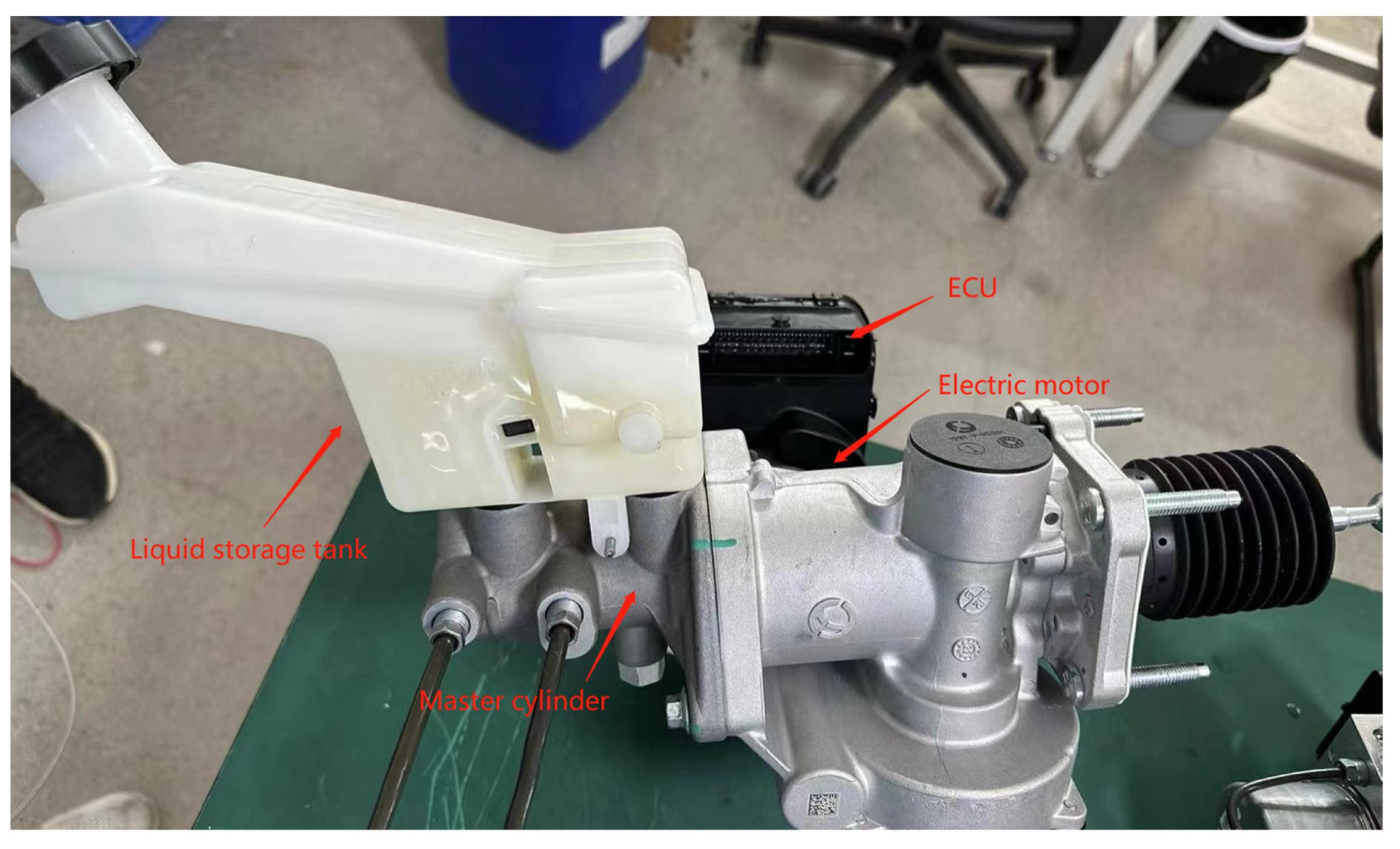
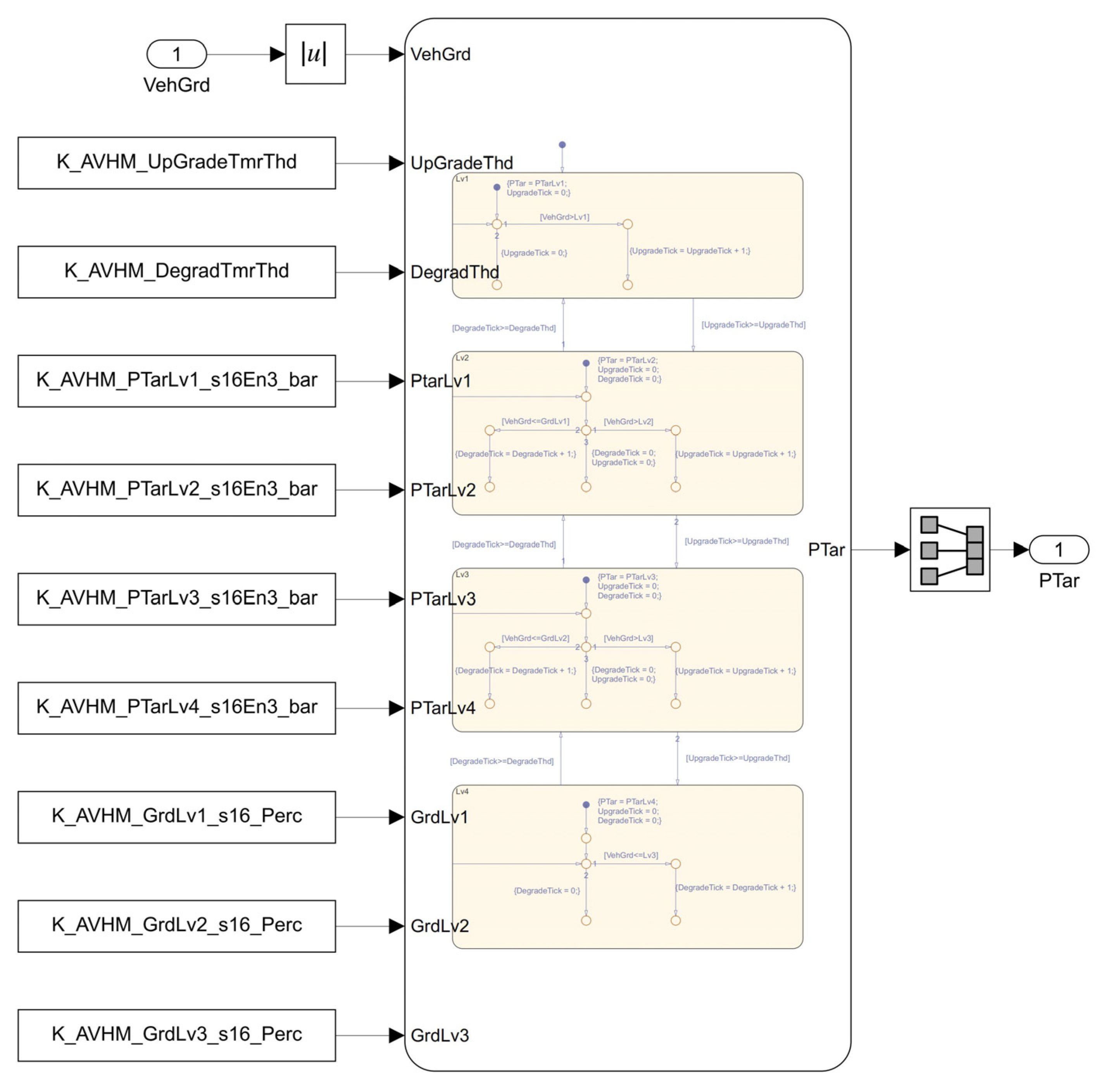
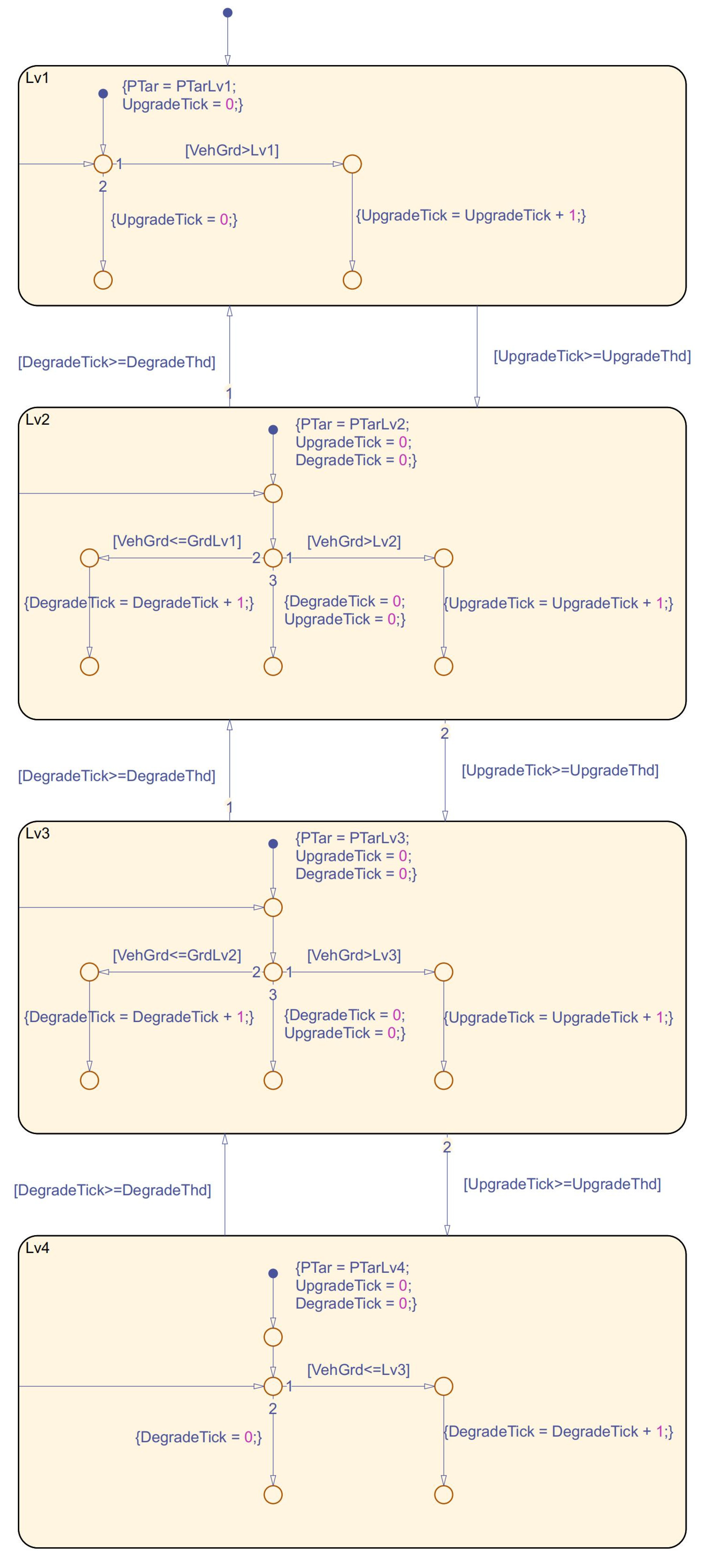
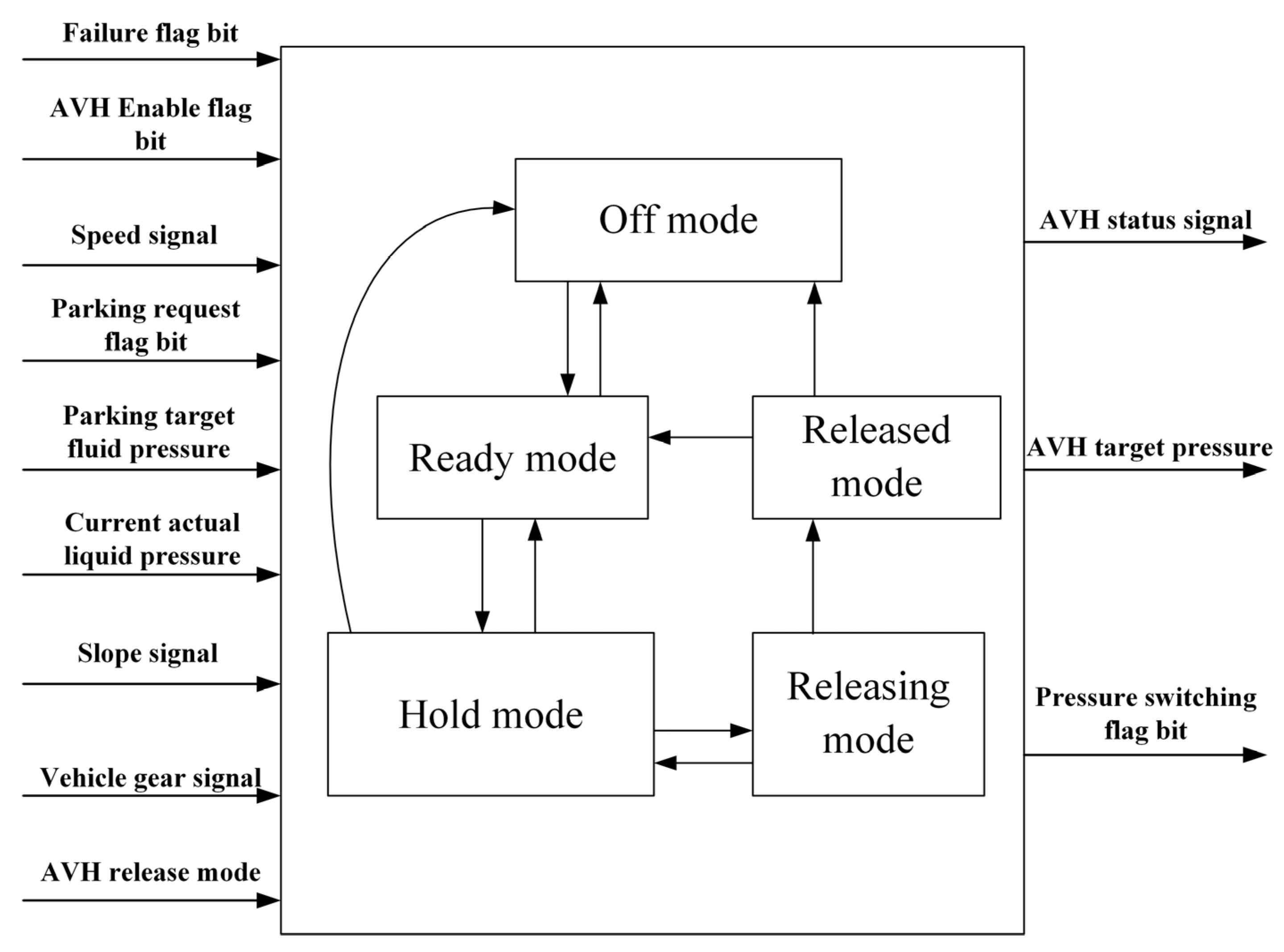



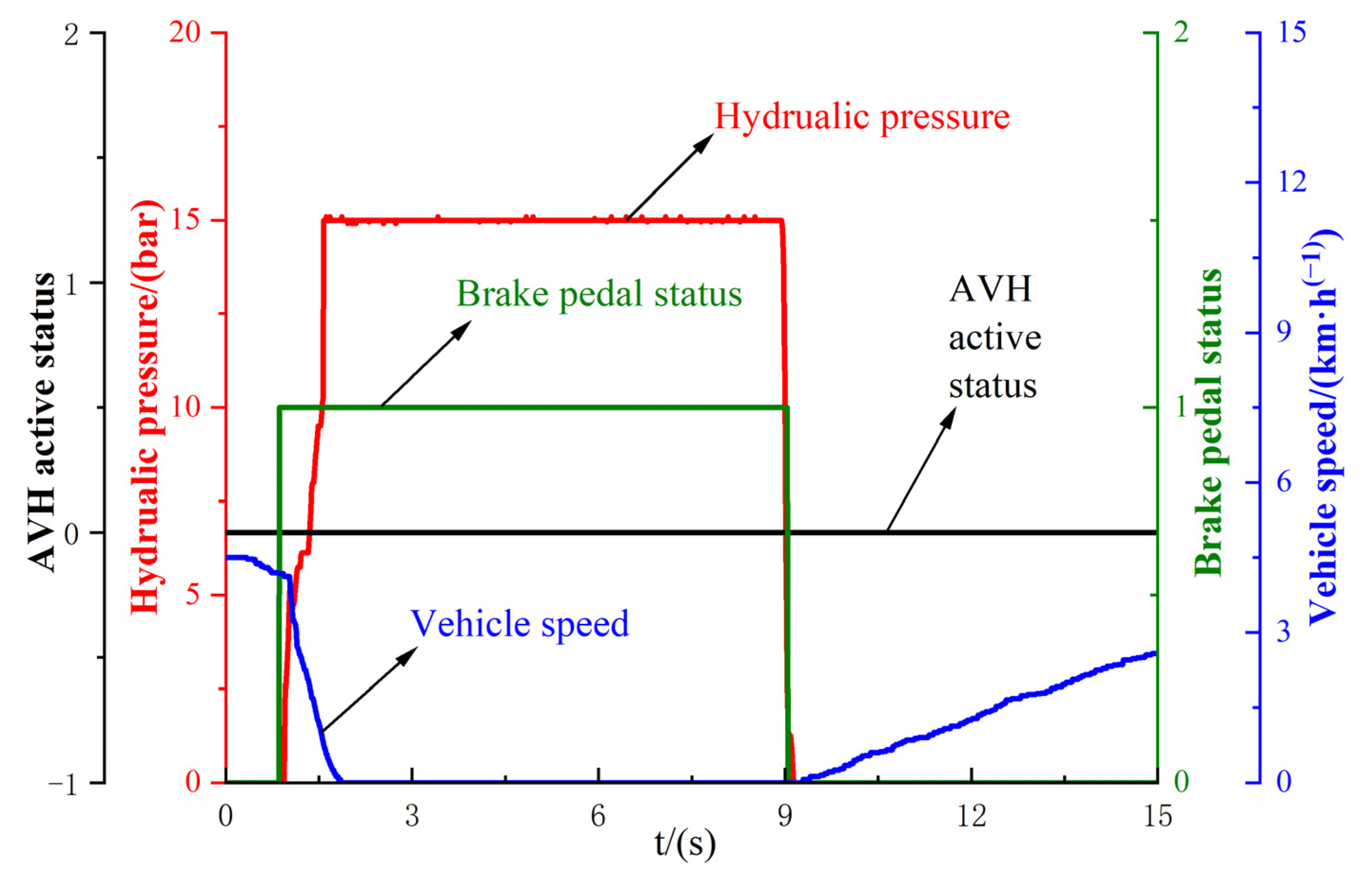

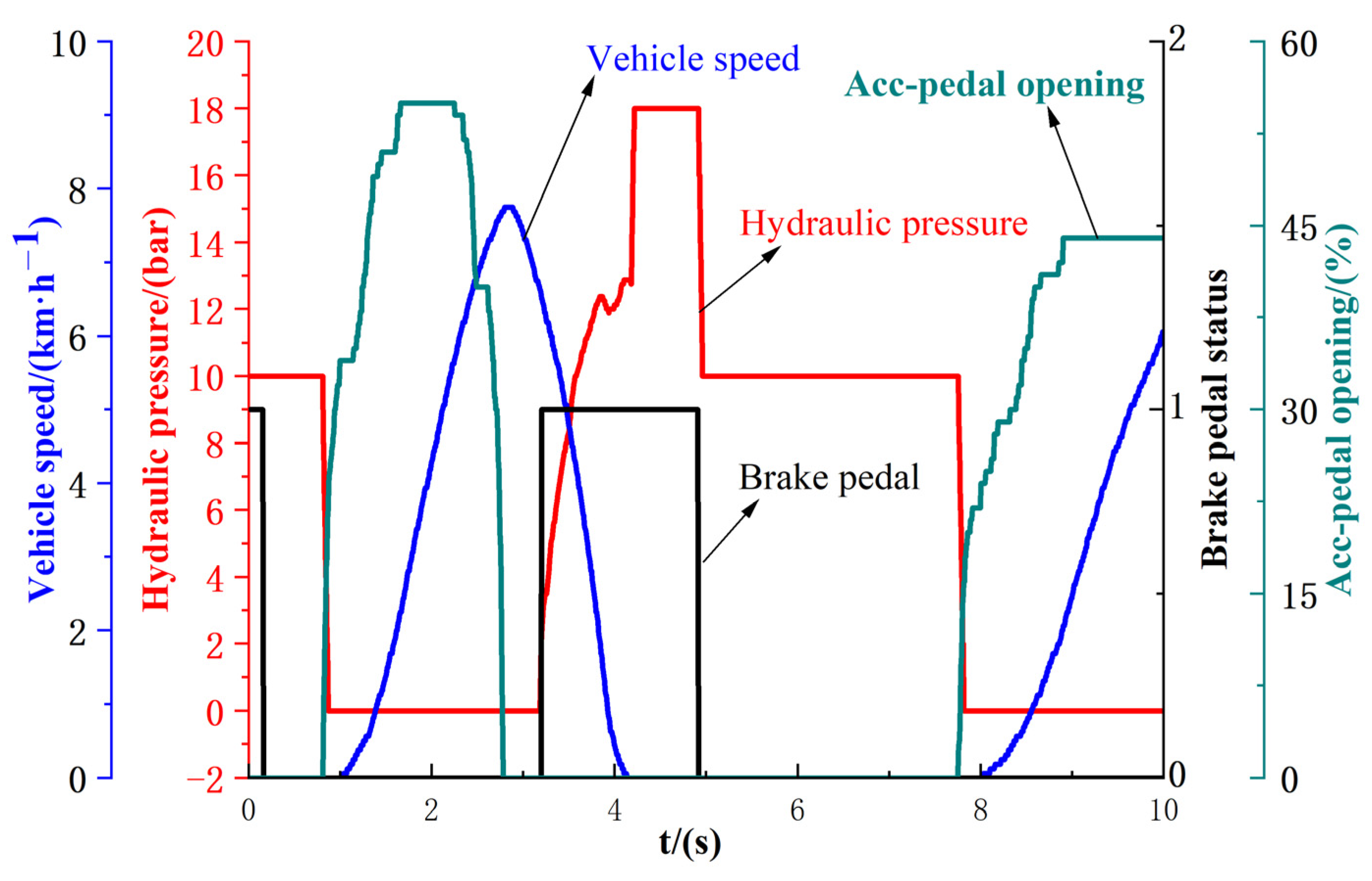
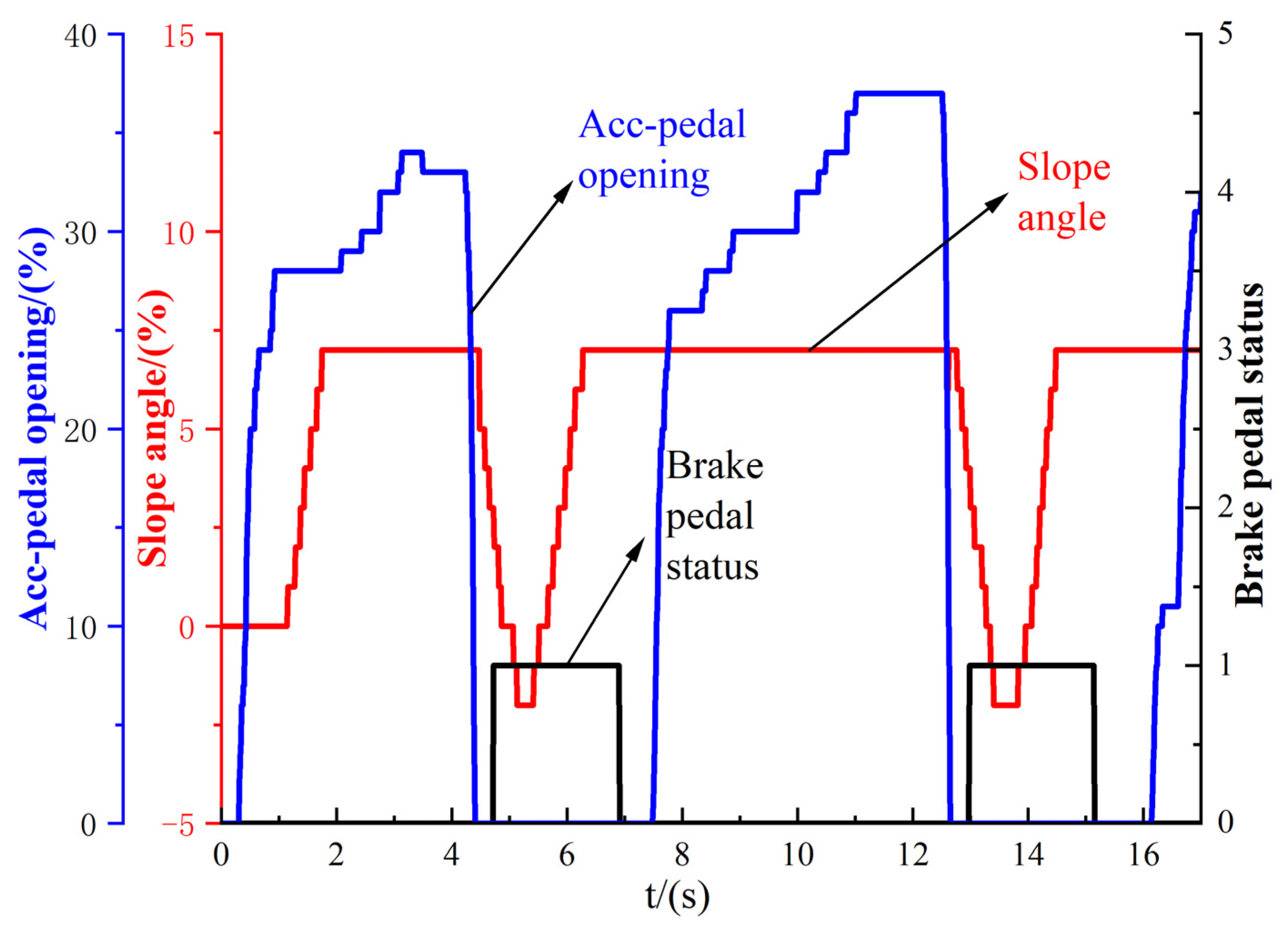
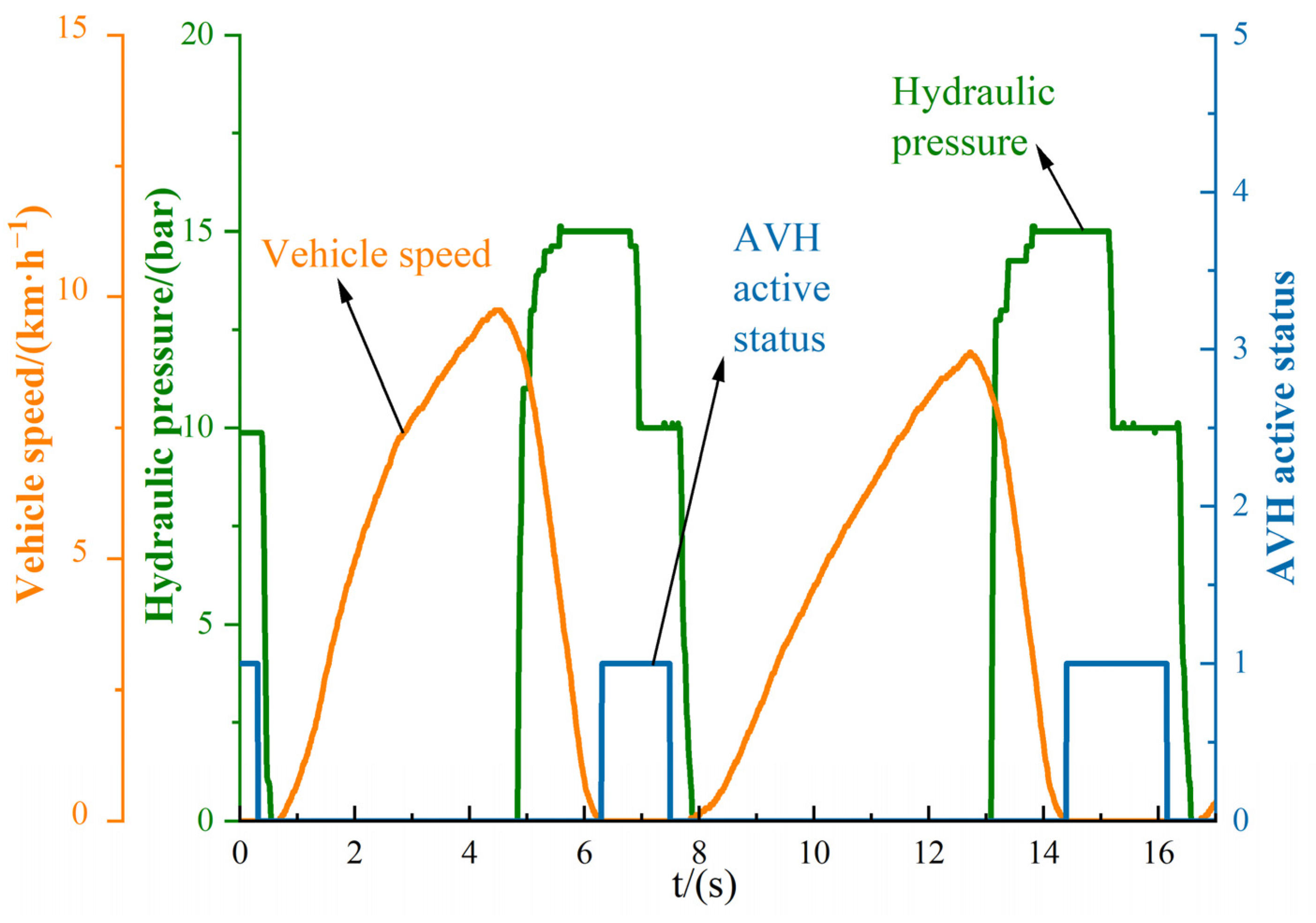

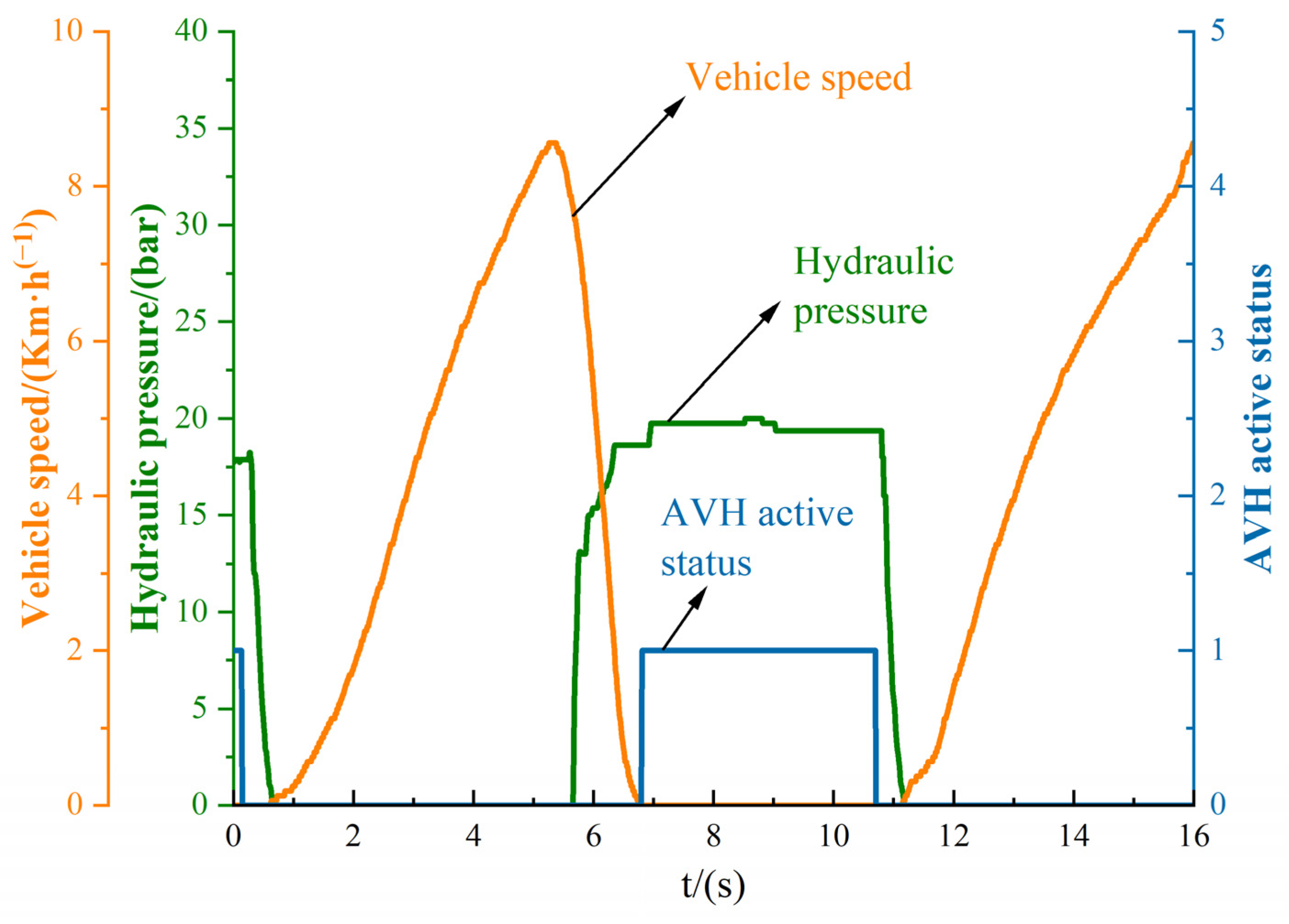
| Parameter Name | Numerical Value | Parameter Name | Numerical Value |
|---|---|---|---|
| Mass of vehicle | 1220 kg | Total motor torque | 120 Nm |
| wheelbase | 2260 mm | Tyre radius | 0.285 m |
| Front track width | 1470 mm | Height of centre of mass | 0.48 m |
| Rear track width | 1460 mm | Moment of inertia | 1490 kg·m2 |
| coefficient of drag | 0.35 | Front area | 2.2 |
| Correction coefficient of rotating mass | 1.3 | Main Reducer Ratio | 7.6 |
| Rolling resistance coefficient | 0.011 | Mechanical efficiency of the transmission system | 0.91 |
Disclaimer/Publisher’s Note: The statements, opinions and data contained in all publications are solely those of the individual author(s) and contributor(s) and not of MDPI and/or the editor(s). MDPI and/or the editor(s) disclaim responsibility for any injury to people or property resulting from any ideas, methods, instructions or products referred to in the content. |
© 2023 by the authors. Licensee MDPI, Basel, Switzerland. This article is an open access article distributed under the terms and conditions of the Creative Commons Attribution (CC BY) license (https://creativecommons.org/licenses/by/4.0/).
Share and Cite
Zhou, Y.; Huang, B.; Liu, J.; Zhou, T. Functional Model of an Automatic Vehicle Hold Based on an Electro-Hydraulic Braking System. World Electr. Veh. J. 2023, 14, 277. https://doi.org/10.3390/wevj14100277
Zhou Y, Huang B, Liu J, Zhou T. Functional Model of an Automatic Vehicle Hold Based on an Electro-Hydraulic Braking System. World Electric Vehicle Journal. 2023; 14(10):277. https://doi.org/10.3390/wevj14100277
Chicago/Turabian StyleZhou, Yufeng, Bo Huang, Jiahao Liu, and Tianjun Zhou. 2023. "Functional Model of an Automatic Vehicle Hold Based on an Electro-Hydraulic Braking System" World Electric Vehicle Journal 14, no. 10: 277. https://doi.org/10.3390/wevj14100277
APA StyleZhou, Y., Huang, B., Liu, J., & Zhou, T. (2023). Functional Model of an Automatic Vehicle Hold Based on an Electro-Hydraulic Braking System. World Electric Vehicle Journal, 14(10), 277. https://doi.org/10.3390/wevj14100277





